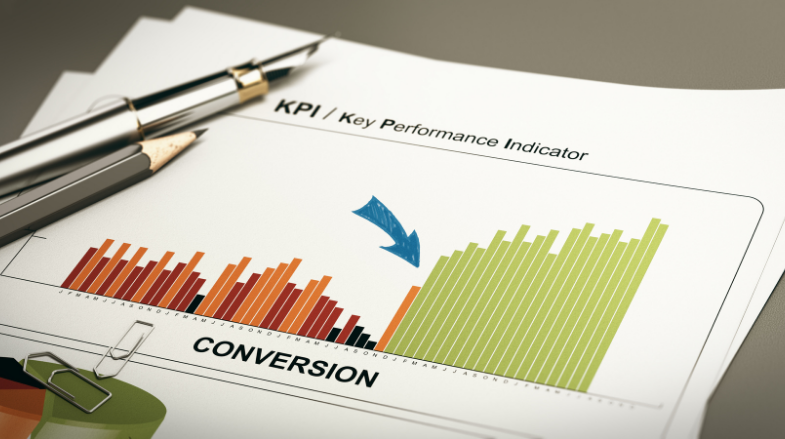Introduction: What is Website Traffic & Why is it Important?
Website traffic is the measure of visitors that come to your website. It can be measured in a number of different ways, including page views, unique visitors, and total visit duration. Knowing how much website traffic you are getting over a certain time period is an important part of understanding the success of your website, as it gives you insight into the amount of people that are visiting your site, and how engaged they are.
There are many advantages to having a good amount of website traffic. Firstly, more website visitors means more potential customers. This means that if you have a well-trafficked website, more people will be exposed to your products or services. Secondly, increased website traffic can also help improve your SEO rankings.
For example, if your website is one of the top-ranking websites for a certain keyword, then Google will view your page as more authoritative and trustworthy, thus placing it higher up in the search engine results pages (SERPs). Finally, higher website traffic means more data collected, which can help you gain important insights into your audience’s behaviour.
In short, website traffic is essential for any business that wants to succeed online. By measuring your website traffic levels, you can make informed decisions on how to improve your website and increase conversions.
Understanding Website Traffic Sources & Where it Comes From
Website traffic is the main source of online business success. Understanding the sources of website traffic and where it comes from is incredibly important for your business. By understanding the different sources and types of website traffic, you can make more informed decisions about how to drive and increase your website traffic.
Website traffic can be divided into two main categories: organic and paid. Organic traffic is generally ‘free’ traffic that is generated from sources such as search engines, social media, referrals or direct visits. Paid traffic is generated through advertising campaigns on platforms such as Google Ads, Bing Ads, Facebook Ads or Instagram Ads.
Organic traffic is often considered the most valuable, since it typically has higher quality visitors that are more likely to convert. Search engine optimization (SEO) is the practice of optimizing your website to be more visible in organic search results, so you can increase the amount of organic traffic your website receives. The more visible you are in search engine results, the more likely you are to receive organic visitors.
Paid traffic is a great way to quickly increase the amount of visitors to your website. However, it does come at a cost, so it is important to consider the short-term and long-term goals of your paid advertising campaigns. Paid campaigns can present a great opportunity to reach new audiences with targeted messaging, but it is important to understand the difference between quantity of visitors and the quality of visitors you are reaching.
In addition to organic and paid traffic sources, there are also other sources of website traffic that should not be neglected. Referral traffic is when someone visits your site after clicking on a link from another site, and direct traffic is when someone visits your site by typing it directly into their browser. Social media can also be a great source of website traffic; creating content that resonates with your target audience can help generate more interest and engagement.
Ultimately, understanding website traffic sources and where it comes from is essential to help you determine the best strategies to increase the amount of website visitors and optimize conversions. By researching the various sources of website traffic and analyzing the data, you can make more strategic decisions and effectively allocate resources to get the best results possible.
Core Components of Website Traffic
When you’re talking about website traffic, there are two key components – sessions, and pageviews. Understanding these two terms is essential if you want to get a better understanding of the importance of website traffic for your business, and how to optimize your website performance.
A website session is an active visit or interaction on your website. It begins when someone visits your website for the first time, and ends when they leave your website. A session can last anywhere from a few seconds to multiple hours, depending on how much time someone spends browsing your website.
Pageviews are the individual pages within a session. Every time a user clicks to view a new page within a session, it counts as a pageview. For example, if a user lands on your homepage, views three different product pages, and then leaves your website, that would count as four pageviews.
To measure the success of a website, you need both session and pageview data. Together, they help to provide a comprehensive overview of your website performance. Sessions reveal how many people are visiting your website, and pageviews show what a user is doing when they’re there. By analyzing this data, you can gain insights into which pages are popular, which are underperforming, and determine potential areas for improvement.
Knowledge of pageviews and sessions can also help youoptimize your website for better conversions. By identifying pages which are performing well, you can dedicate more energy to optimizing those pages, and ensuring they are delivering visitors the information they need to become customers.
Quantifying Website Traffic Levels
It’s important to be able to accurately quantify the amount of website traffic that your website receives as this can help you measure performance and provide insight into the effectiveness of your digital strategies. By understanding the amount of visitors to your website, you can evaluate how well campaigns and incoming traffic sources are performing.
Websites track visitor numbers through analyzing web analytics data. This involves measuring a range of different metrics, from the number of page visits to the number of visitors that have subscribed or completed a purchase. These metrics can help you identify what content is doing well and what content may need improvement.
You can also use web analytics to measure bounce rate, which records when someone visits your website but immediately leaves. If a lot of visitors are bouncing, it can indicate that something about the website isn’t appealing, and you should investigate why this is happening.
It’s useful to compare web analytics data with other data that you collect around customer behaviour, such as email open rates and click-through rates. This will show you how successful your website traffic has been in terms of generating engagement.
By gathering more data and setting specific goals, you can begin to analyze and monitor your website traffic more effectively. Comparing your website performance against these goals will help you identify any areas for improvement and take proactive steps to increase website traffic and conversions.
Analyzing Website Traffic in Detail – What Driving Factors Should You Consider?
When analyzing website traffic, it’s important to consider the various driving factors and how your decisions can influence the visitor experience. There are a few key elements that you should look at when assessing website traffic, such as the referral source, the type of traffic, and the geographical location.
Referral Sources
It’s important to analyze which websites are referring visitors to your site. These referrers can include links from social media platforms, other websites, or search engine results. Knowing what sources are driving the most traffic helps you understand where your audience is coming from, and how you can optimize these sources for improved success.
Type of Traffic
Another factor to consider when analyzing website traffic is the type of visitor you’re attracting. Do the visitors come from organic search, direct visits, or referral links? Understanding the different types of visitors can help you know where to focus your optimization efforts and what strategies you should put in place.
Geographical Location
It’s also important to consider the geographical location of visitors. Are they coming from different countries or regions? Knowing this information helps you identify any potential target markets and allows you to tailor your content and services accordingly.
Conclusion
By analyzing these driving factors, you can get a better understanding of the visitors coming to your website and make more informed decisions regarding website optimization and growth. This in turn will help you increase website traffic and improve conversions.
Setting Goals for Website Traffic & Making Strategic Choices
Having clear goals is key to driving website traffic. With a well-defined goal, you are able to focus your efforts and measure the effectiveness of your strategies. This helps you optimize and expand your reach.
In addition to setting quantifiable goals, you should also consider the quality of traffic. Relevant and engaged website visitors will help your business grow. Identifying the methods and sources that bring in high-quality traffic is an essential part of creating a successful online presence.
Once you have defined your goals and identified the sources of quality traffic, you can begin making strategic marketing choices. For example, paid search engine marketing can be used to target specific countries and devices; social media marketing campaigns can be used to target users with specific interests; and email marketing campaigns can be used to increase engagement with prospects and customers.
You must carefully evaluate the effectiveness of these different types of strategies and focus your efforts on those that deliver the best results. For example, if your goal is to drive conversions, you should focus more on pay-per-click campaigns rather than building organic traffic.
By taking the time to set reasonable goals, identify the sources of quality traffic, and make thoughtful strategic choices, you can ensure that you are maximizing the potential of your website traffic.
Aligning Your Website Objectives with Your Website Traffic Goals
If you’re looking to increase website traffic, it’s important to ensure that your website objectives are aligned with your website traffic goals. By understanding what you want to achieve with your website, and the types of visitors that will help you get there, you can adjust your strategy to ensure you are getting the most out of every visitor.
To start, you must first know what your website objectives are. Are you looking to promote brand awareness? Sell products? Provide customer service? Understanding this key objective will help you determine the type of website traffic that will help you achieve success.
Once you’ve identified your web objectives, you can begin to look at how to strategically target the right type of website traffic. You’ll need to research which channels bring in the most relevant visitors for your website objectives. For example, if you’re looking to increase sales, then focusing your efforts on SEO or social media campaigns that target high-converting customers is a great way to drive relevant traffic.
Moving further, you’ll need to set goals for the specific type of website visitors that you’re trying to attract. It’s important to establish both qualitative and quantitative goals for your website traffic. Qualitative goals generally involve understanding the type of customers that visit your site and how they engage with your product or service. Quantitative goals are typically more focused on numbers, such as website visits, page views, or conversions.
By breaking down your website objectives, researching the right channels to target, and setting meaningful goals, you can ensure that your website traffic efforts are aligned with your website goals and objectives. Doing so will allow you to maximize the value of each visitor and ultimately help you achieve your success.
Measuring the Impact of Your Website Traffic Efforts
Measuring website traffic is an important tool for any website owner. It helps you to understand if and how visitors are interacting with your website, as well as see which pages they visit and how they interact with it. By understanding website traffic and analyzing the data, you can make informed decisions on how to optimize your website and reach your desired goal.
The most basic way to measure website traffic is to look at the raw number of users that visit your website. This gives you a general overview of the level of engagement and allows you to identify trends. You can also delve deeper and measure the number of unique users that visit your website, as well as the frequency of visits and length of time spent on each page. All of this data can give you a better idea of the quality of the traffic you’re getting and how engaged users are with your content.
You should also measure the effectiveness of your website traffic efforts by tracking the goal conversions of your visitors. Goal conversions refer to the number of visitors who complete a desired action (such as signing up for an account or purchasing a product). By tracking goal conversions, you can ascertain the success of your website traffic efforts, as well as identify areas where you can improve.
To measure the impact of your website traffic efforts more accurately, you should track your key performance indicators (KPIs) such as website bounce rate, average session duration, and average pages per session. These KPIs can help you understand exactly how effective your website traffic efforts are in helping you reach your desired goals.
In summary, measuring the impact of your website traffic efforts is essential to assessing the effectiveness of your website and ensuring that it’s reaching the right audience. By tracking KPIs such as website bounce rate, average session duration, and goal conversions, you can get a better idea of how engaging your website traffic is and how successful your efforts have been.
Introducing Website Conversion & How it Affects Your Business
When it comes to creating a successful website, it’s important to understand what website conversion is and how it affects your business. Website conversion is the process of turning your target audience into customers or supporters of your business. This is done through optimizing your website to be engaging, informative, and helpful so visitors take the desired action.
One of the ways to increase website conversions is by driving quality website traffic. Quality website traffic refers to visitors who are more likely to be interested in what you have to offer. These visitors are more likely to take the desired action, such as signing up for a newsletter or making a purchase. Driving quality website traffic means understanding your audience and targeting them with an effective marketing strategy.
Another important factor to consider when it comes to website conversion is the design of your website. It’s important to make sure your website is easy to navigate, aesthetically pleasing, and loaded with useful information. You should also ensure that the website content is optimized for search engines. This will help to draw more visitors to your website.
Finally, you should also focus on refining the overall user experience of your website. This includes ensuring that loading times are fast and that pages are responsive across different devices. If users get frustrated with slow loading times or poor design, they are less likely to complete the desired action.
By understanding website conversion and taking the necessary steps to optimize your website, you can drive more quality website traffic and boost conversions. This will lead to higher revenue and more satisfied customers.
Optimizing Website Conversion by Driving Quality Website Traffic
As a website owner, you know how important it is to have high-quality website traffic. But how do you turn that website traffic into sales and conversions? That’s where website conversion optimization comes in. Conversion optimization is the process of optimizing your website to increase the number of people who take a desired action, such as making a purchase or signing up for a newsletter.
When it comes to website conversion optimization, the first step is to drive quality website traffic. This involves targeting visitors who are likely to take the desired action on your website. For example, if you are selling a product, it is important to target visitors who are interested in your product. You can do this by using targeted keywords, creating relevant content, and increasing your website’s visibility on search engines.
Once you have attracted quality website traffic, the next step is to optimize your website for conversions. This means making sure that your website is easy to navigate, includes clear calls to action, and features a fast loading time. It also means improving the look and feel of your website, ensuring that it is user-friendly and contains helpful content.
Finally, you need to measure the success of your website conversion optimization efforts. Tracking metrics such as page views, bounce rate, and conversion rate can help you identify which parts of your website are working well and which areas need improvement. By understanding these metrics, you can make informed decisions about how to optimize your website and increase your conversions.
In conclusion, website conversion optimization is an essential part of running a successful website. Driving quality website traffic is the first step, but it is only the beginning. To maximize the impact of your website traffic, you need to ensure that your website is optimized for conversions. By measuring the success of your optimization efforts, you can identify areas for improvement and maximize the value of your website traffic.
Strategies to Increase Website Traffic & Boost Conversions
If you’re looking to increase website traffic and boost conversions, there are a few techniques you can employ. It’s important to keep in mind that when it comes to strategies for driving website traffic, the end goal should always be to drive website visitors who are interested in your business’s products or services.
The key to success is having a solid strategy with multiple tactics, along with an understanding of how these strategies can work together to achieve the desired outcome. Here are some tactics you can use to drive website traffic and increase conversions:
- Identify who your audience is and where they are online.
- Develop a content strategy that speaks to your audience’s interests.
- Invest in search engine optimization (SEO) to improve your ranking in organic search results.
- Start building relationships with influencers or potential partners.
- Engage with your audience on social media.
- Run and optimize paid advertising campaigns on social media.
- Develop an email newsletter program.
- Create content such as eBooks, white papers, and case studies.
- Optimize your website for better user experience.
- Analyze and track your website performance to make changes where needed.
These are all great tools to help you see more website traffic and higher conversion rates. However, it’s important to note that it is not a one-size-fits-all approach and each business will need to find the strategies and tactics that work best for their specific industry and target audience. Ultimately, it’s important to remember that successful website traffic and conversions start with a well-defined plan, the appropriate tools for execution, and – most importantly – continuous testing and tracking.
Summary & Conclusion – Re-Evaluating Your Website Performance Goals
In this guide, we’ve provided you with the insights you need to understand website traffic and conversion. Over the course of 12 sections, we have discussed the importance of website traffic, how to measure and analyze website traffic, and strategies to boost your conversions.
As you look back on these topics and tools, it is important that you reflect on and re-evaluate your website performance goals. Keeping a close eye on both website traffic and conversions is key to understanding the health of your website and being able to make strategic decisions about it.
When setting and evaluating your website goals, consider metrics that are more specific and measurable such as traffic acquisition costs, visit frequency, and funnel drop-off rate. Additionally, be sure to prioritize quality over quantity and focus on driving high-value users to your website. Finally, continuously monitor and optimize your website performance goals to ensure that you are achieving the best results possible.
By following the topics and tools in this guide, you should now have an understanding of website traffic and conversions and be able to set and evaluate your website performance goals appropriately.
How to Understand and Leverage Website Traffic & Website Conversions
- Q: What is website traffic?
A: Website traffic is the activity and volume of visitor interactions with a website, which are often measured as page views, sessions and hits. - Q: What are the core components of website traffic?
A: The core components of website traffic include the volume of visitors, the page views, the duration of visits, the sources of traffic, and any other relevant user activity. - Q: How can I quantify website traffic levels?
A: You can quantify website traffic levels by tracking metrics such as the total number of visitors, time spent on pages, pageviews, bounce rate, and user goals achieved. - Q: How can I set goals for website traffic?
A: When setting website traffic goals, you should consider your website objectives, the demands of your target audience, and the goal of your website. Additionally, you should consider budget constraints, desired outcomes, and desired action for visitors. - Q: What is website conversion?
A: Website conversion is when a website visitor completes a desired action such as signing up for a newsletter, downloading content, or making a purchase. - Q: How can I increase website traffic and boost conversions?
A: There are several strategies to increase website traffic and boost conversions, including optimizing content for search engines, leveraging social media, and increasing conversion rate optimization tactics like A/B testing. - Q: What should I use to measure the impact of my website traffic efforts?
A: To measure the impact of your website traffic efforts, you should use reliable analytics tools such as Google Analytics or Adobe Analytics to track key performance indicators like conversions, bounce rate, visits, and traffic sources.






